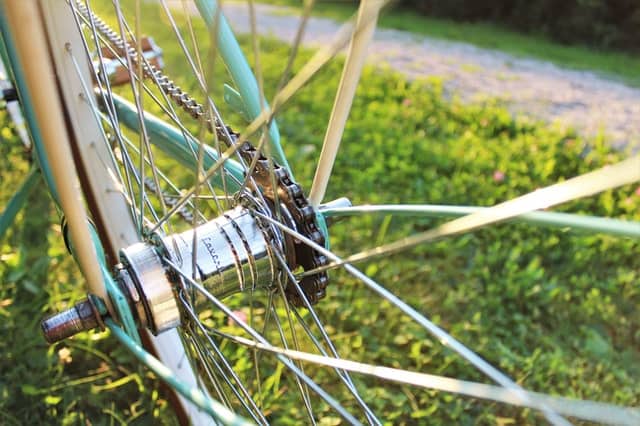The bike chain is undoubtedly one of the most important components of any bike. It allows power to be transferred to the wheels, which helps you pedal and move forward. If you notice that your bike chain keeps coming undone or becoming loose, it might be time that you tighten it. This is extremely important as saggy and undone chains can cause an accident because they don’t allow you to pedal faster or move smoothly.
Loose bike chains are a common occurrence for regular cyclists. However, it does not mean that there’s something wrong with your bike. It can happen to several types of bikes, whether single-speed or multi-chain bikes.
The good thing is that you do not need to take your bike to a cyclist or a professional to get it fixed. This process is extremely straightforward and can be done on your own. With just a few easy steps, you can tighten your loose bike chain in no time.
Read How To Clean a Bike Chain with Household Products: The Ultimate Guide
In this guide, we will walk you through each of these steps and discuss the importance of tightening bike chains. It will also answer some frequently asked questions you might have about this component of the bike.
What Causes a Loose Bike Chain?
Even when you take care of your bike and maintain it regularly, the bike chain can still become loose. There are a couple of reasons why this happens. The most common reason is due to wear and tear.
Over time, the links on the chain start to pull apart each time you pedal and ride your bike. Similarly, the chain can become worn and smooth, which causes it to loosen.
This is also because of the components that hold the chain start to wear down because of regular cycling. The parts of the chain become worn down, so it would still probably be loose even if you put in a new chain.
This is when replacing the bike chain or the parts are not needed, but rather tightening it. Additionally, the axle nuts can also loosen on the rear axle that can cause the chain to loosen.
The other common reason why bike chains come loose depends on the type of bike you have. For single-speed bikes with an internal gear hub, the chain may have come loose because the wheel is not aligned and needs to be adjusted properly.
On the other hand, for multi-gear bikes, the gears are changed and controlled through a mechanism called a derailleur. Their purpose is to maintain the tension in the chain with the help of a built-in spring.
When the chain on the multi-gear bikes comes loose, you will need to adjust or replace the derailleur to fix it.

Read How to Clean A Mountain Bike Chain – Ultimate Guide
How to Tighten a Bike Chain
The exact process of tightening a bike chain differs according to the type of bike you have. As we mentioned earlier, the cause of the bike chain becoming loose differs according to a single-speed bike and a multi-gear bike. This is why the process of tightening and fixing the chain also differs. Here, we will walk you through the process of tightening the bike chain on both types of bikes.
How to Tighten a Bike Chain on a Single-Speed or Single-Gear Bike
If you are a newcomer to the cycling world, you might be wondering what a single-speed bike is. In simple words, it is a bike that has only one gear, which is why it is also sometimes called a single gear bike.
Instead of a freewheel mechanism to move the bike, this type uses a cog mechanism. The cog is what turns the wheel when you pedal. Here’s what you need to tighten the chain on your single-speed bike.
Tools You Need
- Bike stand
- Socket wrench
- Dry bike lubricant
- Gloves
- A cloth/old rag
The Procedure
1. Flip the Bike and Set it up
You need to be in a comfortable position in order to clearly see and access the parts of the chain when you are tightening it. This is why you will need to flip the bike upside down or set it on a bike stand.
2. Loosen the Rear Tire
To do this, you will need to loosen the axle nuts that are holding the rear wheel. This is where a socket wrench can come in handy. Turn the wrench in the anticlockwise direction that will eventually loosen the axel nuts.
3. Slowly Pull Back the Rear Wheel and Recognize Tightness
Pulling back the rear wheel will help increase the tension in the chain. However, be sure to do this slowly and take your time with it.
Otherwise, the chain might snap. Keep checking the tension on the chain as you pull back and stop when you feel that it has reached the right level.
The best way to recognize the right level of tension on the chain is to move it half an inch in both directions. If you have moved them too far, the chain will become too tight, and you won’t pedal properly.
This can be too much of a hassle, so be sure to complete this step carefully.
4. Fix the Rear Tire Back into Place
When you think that the bike chain has reached the perfect tightness, it’s time that you put the rear tire back into its position. You will need to use the same socket wrench to screw the nuts back on the axel.
But this time, make sure that you are screwing it in a clockwise direction. You can stop once you feel it has reached the ideal tension.
Then, ensure that the back tire has been properly fixed. In order to be sure, you will need to check to make sure that the tire is not touching the bike frame or chain.
5. Recheck and Test Your Bike
Once everything has been fixed into place, it is important that you first test your bike before riding it. You must move the bike in either direction to ensure that it can move about half an inch in both directions.
As part of your testing, you should also spin the bike and see if it does this smoothly and does not come into contact with the frame or chain.
Moreover, if the chain is not moving in both directions properly, you will need to repeat the above steps again. If your chain still sags when you ride it, then the problem must be with the chain, and you will need to replace it.
Read How to change bike brake pads and When

How to Tighten a Bike Chain on a Multi Gear Bike
Multi-gear bikes, such as mountain bikes, come with a derailleur and have chains that can be quite dangerous if not tightened. This is because your foot can get caught in the loose chain, and that can result in a pretty serious injury.
Hence, if you have noticed that the chain is loose, you should stop riding your bike and walk it to a safe place.
The Procedure
Here is how you can tighten a bike chain on bikes with a derailleur known as a multi-gear bike.
1. Position Your Bike Correctly
You will need to position your bike properly if you want to access the derailleur easily. To do this, you can set it on a bike stand or turn it on its back so that the bike can rest on the handlebars.
2. Locate the Derailleur Screw
On most multi-gear bikes, there is a screw attached to the back of the derailleur. On most of the bikes, there is a letter B next to it. Turn this screw with a socket wrench in a clockwise direction if you want to increase the chain’s tension.
3. Reach the Rear Tire
This is a little different than the single gear bikes. You will need to disconnect the brakes from the cable first. Then, you will be able to access the rear tire.
4. Adjust the Rear Tire
First of all, you will need to slide the wheel axle behind the rear dropouts. This will allow you to lower the lever. Make small adjustments to the chain so that it does not tighten too much.
After you make each adjustment, you should lower the brake lever, which will allow you to check the tension in the chains.
When you feel like the chain is not tight enough, then lift up the lever and make more adjustments. Keep doing this until you feel like the chain has reached the ideal level of tightness.
5. Put the Bike Back Together and Check If Everything Is in the Right Place
The last step is to check whether the derailleur screw has been tightened to the bike properly. Then, check to see if the tire is spinning properly without making any contact with the bike frame or chain.
If you feel like the tension and tightness of the chain are still not enough, you can repeat this process.
You should also check whether the quick release lever is down or not. Then, reattach the cable. Take a look at all of the components of the bike before going out for a ride and testing the chain.
Read How to Make a Bike Seat More Comfortable
Bike Chain Problems
Whether you have a single gear or multi-gear bike, you might notice that even after completing each of the above-mentioned steps, the bike chain is still sagging and is loose.
In this case, where you feel like the chain is not how it should be, you might need to replace it. However, you will first need to examine the derailleur and wheel position and see if they are to blame.
To check if your chain needs to be replaced, you will need to measure it first. You can do this by using specific chain measuring tools that have prongs on either side. If the chain is too long on a multi-gear bike, then the derailleur might not be able to hold it sufficiently.
You can alternatively also take your bike to the bike shop and have them examine the length of the chain. If they think it is too long, they will cut a few links to shorten it or replace the chain altogether.

Read Best Road Bikes Under $500
Frequently Asked Questions
There are some common questions that avid cyclists have in mind when it comes to bike chains and their efficiency. In this section, we will answer all of them.
1. How Do You Maintain Bike Chains?
The bike chain is quite efficient most of the time and requires very little maintenance. In fact, the only thing you need to do to maintain it is to lubricate it every now and then.
To do this, you will need special liquid lubricants. Avoid using regular lubricants because they tend to catch dust. Dry lubricants are also a good option as they keep the chain clean.
The second thing you will need to do to maintain the bike chain is clean it regularly. You can do this before you apply the lubricant. It is especially important that you apply the lubricant on the chain only after you have cleaned it.
If you do it on a dirty chain, it will damage the entire thing. Dry lubricant comes especially handy in such cases because it helps to clean and lubricate without minimal effort.
2. When Is It Time for Me to Change my Bike Chain?
A general rule is that you must change your bike chain after you have ridden over two thousand miles on it. Another way to check whether it is time for a change is by measuring the length of the chain. If it is too long, then you will need to change it.
3. How Tight Should a Bike Chain Be?
When you tighten the bike chain, it should have a movement of about half an inch in either direction. If you notice that it is still sagging and not too tight, that could be because the chain is too long.
This is common since the links tend to stretch and expand. You can remove some of the links to shorten the chain and tighten it.
4. Does Lubricating the Chain Affect its Tension and Tightness?
Yes, it does. If you don’t regularly lubricate the chain, it will catch rust and begin to wear down. This will affect its performance, and it will start to sag and slack more often. The dirty chain will make the chain sag more.
However, when you lubricate the chain, you protect it from rust and make it last for longer. This will allow the chain to do its job more effectively, and you won’t need to tighten it as often either or even replace it.
5. Is It Better to Tighten a Bike Chain or Replace It?
This depends on a few factors. If your bike chain becomes loose because it is too old, then you must replace it. Bike chains tend to be expensive. However, they are worth the price because they extend the overall life of the bike.
On the other hand, if your bike chain is relatively new, it’s best to tighten it and not simply go through the extra cost.
6. What Is the Easiest Way to Tighten a Bike Chain?
We understand that the DIY method mentioned above may seem complicated to some people. Unfortunately, there is no easy way around this, and you will either have to do it yourself or take your bike to the bike shop.
There, the professionals can do it for you. This will ensure that the job is properly done and all adjustments are made.
You may also like the following biking articles:
- How to Clean A Rusty Bike Chain?
- How much air pressure in bike tires
- How Do Tubeless Bike Tires Work and Should You Switch to Them?
- Do Electric Bikes Save You Money?
- How to Remove Rust from Bikes [6 Best and Doable Ways]
- How to Convert a Mountain Bike to a Road Bike
Summing It Up
Tightening a loose bike chain is not entirely a complicated process, though it may seem extensive. All you need to do is make sure that you have set your bike in place properly and examine all the components of the bike.
Then, depending on what type of bike you have, you will need to loosen the screws or the derailleur and adjust the chain’s tension.
If you feel like this is too much of a daunting task, then you can take your bike to the shop, where they will properly make all the adjustments. With the above-mentioned tips, you will also be able to decide whether tightening your bike or replacing it is a better option.
Don’t forget to practice proper maintenance of your bike and clean and lubricate it often. All of this will extend the life of the chain, and ultimately the bike itself. Good luck!

I am Michael, an avid rider and bike expert. I am here to provide, biking tips and expert advice on in-depth bike reviews covering features, capabilities, price range, and much more. Specially on electric bikes, mountain bikes, road bikes, etc. I will provide honest product reviews, along with expert advice on purchasing, training, and maintenance. Check out my complete profile.